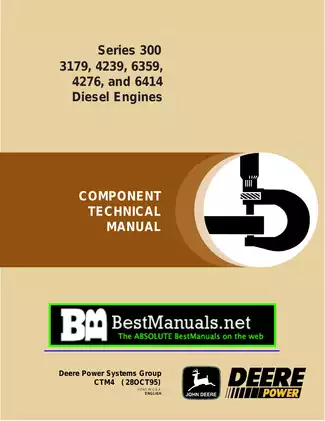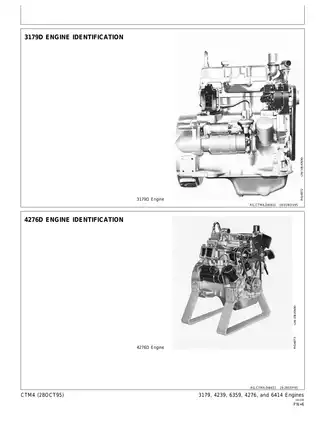Official John Deere 300 Series Diesel Engine: Models 3179, 4239, 6359, 4276, 6414 – CTM4 Component Diagnostics & Repair
Product Gallery

Sample pages from the Official John Deere 300 Series Diesel Engine: Models 3179, 4239, 6359, 4276, 6414 – CTM4 Component Diagnostics & Repair manual


Purchase Information
John Deere 300 Series Diesel Engine Component Technical Manual (CTM4) - Technical Specifications
- Document Number / Seller:
- 28568 / Laura Scott
- File Size:
- 19.73 MB
- File Type:
- Language:
- English (some of our manuals are multi-language)
- Pages:
- 547
- Printable:
- Yes
- Estimated Download Time:
- 0.4 Minutes
- Delivery Format:
- Digital (PDF) - Instant Access
- Category:
- Diesel Engine
- Brand:
- John Deere
- Reviewed and Approved:
- Sep 1, 2025
John Deere Models and Parts Covered in this Diesel Engine Manual
- 3179
- 4239
- 6359
- 4276
- 6414
Complete Manual Information
John Deere 300 Series Diesel Engine Component Technical Manual (CTM4)
This comprehensive Component Technical Manual (CTM4) provides detailed repair and maintenance instructions for the John Deere 300 Series Diesel Engines, specifically models 3179, 4239, 6359, 4276, and 6414. This manual is designed for experienced technicians looking to perform repairs and updates on these engines. It contains critical safety information and instructional guidance necessary for the successful operation, testing, and repair of the components involved.
What's Inside
Table of Contents
- Safety
- Handling fluids safely
- Preventing acid burns
- Preparing for emergencies
- General Information
- Engine Model Designation
- Torque specifications
- Lubricants and coolant requirements
- Engine Mounting
- Engine repair stand setup and precautions
- Engine Repair
- Disassembly and assembly sequences
- Inspection of cylinder heads and valves
- Piston and Rod Assembly
- Detailed steps to disassemble, inspect, and reassemble piston and rod components
- Specifications
- Detailed specifications for engine components including tolerances and wear limits
- Innovative Maintenance Techniques
- Procedures for effective cleaning and inspection of engine parts
- Best practices for installing new components and optimizing performance
Whether you are completing routine maintenance, major repairs, or rebuilding the engine, this manual provides you with all the essential information, ensuring a thorough understanding of the engine’s components and functions.
Take control of your John Deere engine servicing with our premium engineering manual that echoes reliability and quality you can trust. Perfect for mechanics, engineers, and DIY enthusiasts.
Download Instructions for John Deere Diesel Engine Manual
Frequently Asked Questions - John Deere Diesel Engine Manual
What does this John Deere manual cover?
This comprehensive service manual covers detailed repair procedures, maintenance schedules, troubleshooting guides, and technical specifications for Official John Deere 300 Series Diesel Engine: Models 3179, 4239, 6359, 4276, 6414 – CTM4 Component Diagnostics & Repair. It includes information for the following models: - 3179 - 4239 - 6359 - 4276 - 6414.
Is this manual suitable for beginners?
Yes, this John Deere manual is designed for both professional technicians and DIY enthusiasts. It includes step-by-step procedures with clear illustrations and safety guidelines for Diesel Engine maintenance and repair.
What file format will I receive?
You will receive this manual as a PDF file (19.73 MB), which is compatible with all devices. The manual is fully searchable and printable for your convenience.
How quickly can I access the manual after purchase?
You'll receive instant access to your John Deere Diesel Engine manual immediately after payment completion. The download link is valid for 3 days, with lifetime re-download guarantee.
Can I print specific sections of the manual?
Absolutely! This digital manual allows you to print any section you need, from individual pages to complete chapters, making it perfect for workshop use.
Customer Reviews and Feedback
Read what our customers say about this John Deere Diesel Engine manual and share your own experience.
Add Comment
This policy contains information about your privacy. By posting, you are declaring that you understand this policy:
- Your name, rating, website address, town, country, state and comment will be publicly displayed if entered.
- Aside from the data entered into these form fields, other stored data about your comment will include:
- Your IP address (not displayed)
- The time/date of your submission (displayed)
- Your email address will not be shared. It is collected for only two reasons:
- Administrative purposes, should a need to contact you arise.
- To inform you of new comments, should you subscribe to receive notifications.
- A cookie may be set on your computer. This is used to remember your inputs. It will expire by itself.
This policy is subject to change at any time and without notice.
These terms and conditions contain rules about posting comments. By submitting a comment, you are declaring that you agree with these rules:
- Although the administrator will attempt to moderate comments, it is impossible for every comment to have been moderated at any given time.
- You acknowledge that all comments express the views and opinions of the original author and not those of the administrator.
- You agree not to post any material which is knowingly false, obscene, hateful, threatening, harassing or invasive of a person's privacy.
- The administrator has the right to edit, move or remove any comment for any reason and without notice.
Failure to comply with these rules may result in being banned from submitting further comments.
These terms and conditions are subject to change at any time and without notice.
Comments (3)